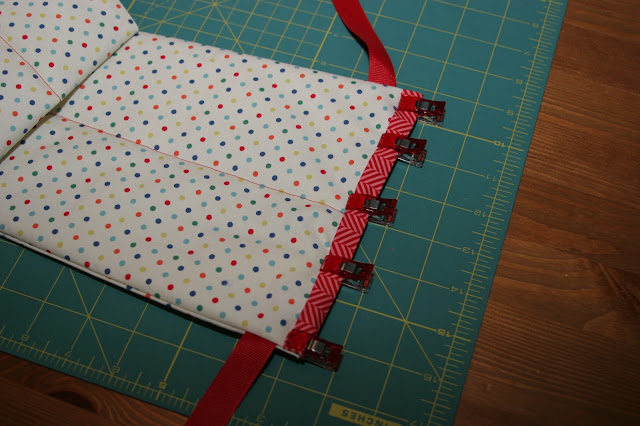This is by no means a full tutorial but rather general guidance on how to make custom rail protectors for your little beaver's crib based upon the steps I took. As always, leave questions in the comments if something is unclear to you.
The first thing you need is a pattern for your covers. Fortunately, my problem-solving husband suggested that I use the toddler bed rail in Madeleine's closet rather than take drastic steps like turning the crib on its side or doing a tag team effort to trace the crib rail in place. Husband FTW. This paper made this part of the project pretty easy. Trace your shape, cut out the pattern, and fold it in half to confirm symmetry.
After making the pattern and getting measurements, construct your top and bottom for each cover. For me, this involved cutting strips of fabric as wide as the cover and then cutting them such that two pieces would form a top or a bottom and have the seam in the middle. I can see a lot of different possibilities here, such as patchwork, stripes, or different fabrics on the top and bottom.
{I didn't take a picture of this step, but this is what you see under the pattern in the photos above and below.}
Once your tops and bottoms are created and seams are pressed out, pin the tops to the bottoms facing each other. Carefully trace your pattern with a disappearing pen (I like this one) and very carefully cut out the shape of your covers. You can unpin the tops and bottoms.
Next, it's time to trace and cut out your pattern on the batting. If you have old textiles laying around, there are probably a bunch of different things you could use as batting (mattress pad, comforter, ironing board cover, etc.). Fusible fleece might work well, too, but I dismissed that idea because I didn't want Miss Madeleine chewing on the adhesive that makes it fusible. I chose to use 1/4-inch batting, and I'm pleased with the result. A giant Sharpie worked well for tracing.
Going back to your tops and bottoms, you want to place your ribbons where you want them and pin them in place. It shouldn't matter if you pin them to the top or bottom, though I'd probably choose the darker of the fabric if that's an option. Pay close attention to the dangly end of the ribbon where the cover gets narrow.
Ribbon length is a personal preference. Mine are six inches long, and I wish that I would have done something closer to four. You'll want them significantly longer if you plan to tie your ribbons in bows.
It's time to make your fabric sandwich. First, lay down the top or bottom with the pinned ribbons. The print and ribbons should be facing up. Next, lay down the partnered top or bottom (the one without the ribbons) with its print facing down, toward the ribbons. Finally, lay the batting on top. Make sure everything lines up properly, and pin your sandwich well. I'd recommend pinning far enough from the edges that you can leave the pins in as/after you sew. Do the same for your second cover.
Head to your machine and sew along the long sides of the covers, back stitching at the ribbons for extra strength. I suggest using the fabric (rather than batting) as your guide and allowing a 1/4- to 1/2-inch seam.
Make sure you've sewn through all layers, take out your pins, and carefully (there are still pins in there!) turn your covers right side out. Remove the pins holding your ribbons in place. Press your covers.
This is a good time to do any quilting or top stitching. I sewed a line down the center at this stage and later went back to top stitch the sides, so it can certainly be done later if you change your mind.
To finish off the ends, you'll want to cut your bias tape to about an inch longer than the ends of your covers. Press the tape so that you have a neat finish on both ends of the tape. Pin (or use the fabulous Clover clips to hold) the tape in place and sew.
Get your ribbons ready for use by trimming them to your desired angle and exposing them to just enough flame to melt and seal the ends.
A few double knots later, and you're done!
A bit of a pep talk: This process seems complicated, but it took me almost as long to type this entry as it did to make the covers. If you can sew a relatively straight line, you can make custom crib rail covers for your crib! Happy sewing!














1 comment:
Beautiful!
Post a Comment